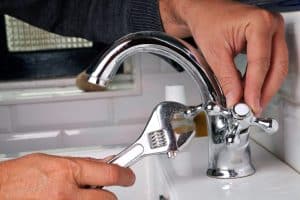
Common Causes of Faucet Leaks
Worn-Out Washers and O-Rings
One of the most prevalent causes of faucet leaks is the deterioration of crucial components such as washers and O-rings. These small, but essential, rubber seals are responsible for creating a tight, watertight seal within the faucet mechanism. Over time, constant use and exposure to water can cause these parts to become worn, cracked, or dislodged, allowing water to seep through and create a dripping faucet.
Damaged Cartridges
For faucets with a single-handle design, the internal cartridge is the key component that controls the flow of water. If this cartridge becomes damaged or worn, it can disrupt the proper sealing and lead to leaks around the handle or from the spout.
Corroded Valve Seats
The valve seat is the connection point between the faucet body and the spout, and it can be susceptible to corrosion over time. As mineral deposits and sediment build up, the valve seat can become pitted or worn, compromising the seal and causing water to leak.
Faulty Faucet Stems
In compression-style faucets, the stem assembly is responsible for opening and closing the water flow. If the stem becomes worn or the internal washers and seals degrade, it can result in a leaky faucet, often with water dripping from the base of the handle.
High Water Pressure
Excessively high water pressure can place undue stress on the various components within a faucet, leading to premature wear and tear. This increased pressure can cause seals to fail, washers to deteriorate, and other parts to malfunction, ultimately resulting in a leaky faucet.
Loose or Broken Parts
Over time, the constant use and vibration of a faucet can cause certain parts to become loose or even break entirely. This can include the handle, the retaining nut, or other internal components, all of which can contribute to water leaks.
Identifying Leaky Faucet Symptoms
Recognizing the warning signs of a leaky faucet is the first step in addressing the problem before it escalates. Some of the most common symptoms to watch out for include:
Dripping Faucet
The telltale sign of a leaky faucet is, of course, the constant dripping of water from the spout, even when the faucet is in the closed position.
Water Stains
Persistent water stains around the base of the faucet or on the surrounding countertop or sink can indicate a slow, ongoing leak that has been causing water damage over time.
Reduced Water Pressure
If you notice a sudden drop in water pressure from a specific faucet, it could be a sign of a problem within the internal components, such as a blocked aerator or a damaged cartridge.
Loose or Wobbly Handles
Faucet handles that feel loose or wobbly when operated can be a warning sign of worn-out parts or a compromised internal structure, potentially leading to leaks.
Unusual Noises
Strange gurgling, whistling, or other unusual sounds coming from the faucet may indicate a problem with the water flow or internal components that could result in a leak.
Preparing for Faucet Repair
Before attempting to fix a leaky faucet, it’s essential to gather the necessary tools and materials. This includes:
- Adjustable wrench or basin wrench
- Pliers or channel-lock pliers
- Screwdrivers (flat-head and Phillips-head)
- Replacement washers, O-rings, and other faucet parts
- Plumber’s grease or silicone lubricant
- Cleaning supplies (e.g., vinegar, toothbrush, rags)
It’s also crucial to shut off the water supply to the affected faucet before beginning any repair work. This can typically be done by locating the shut-off valve under the sink or, in some cases, the main water supply line to the entire house.
Disassembling the Faucet
Once the water is turned off, the next step is to carefully disassemble the faucet. The specific process will vary depending on the type of faucet, but the general steps are as follows:
- Remove the faucet handle(s) by unscrewing any visible screws or prying off any decorative caps.
- Unscrew the retaining nut or collar that secures the faucet body to the sink.
- Carefully lift out the faucet stem or cartridge, taking note of its orientation and any springs or washers that may be attached.
- Inspect the internal components, including the valve seat, washers, and O-rings, for signs of wear or damage.
Repairing and Replacing Faucet Parts
Once you’ve identified the source of the leak, it’s time to replace any worn-out or damaged parts. This may involve:
- Replacing washers and O-rings
- Cleaning or replacing the valve seat
- Replacing a faulty cartridge or stem assembly
- Tightening or securing any loose components
Be sure to consult the manufacturer’s instructions or seek guidance from a hardware store associate to ensure you obtain the correct replacement parts for your specific faucet model.
Reassembling and Testing the Faucet
After replacing the necessary components, carefully reassemble the faucet in the reverse order of disassembly. Remember to apply a small amount of plumber’s grease or silicone lubricant to the moving parts to ensure smooth operation and prevent future leaks.
Once the faucet is fully reassembled, turn the water supply back on and test the fixture for any remaining leaks. If the dripping persists, double-check your work and consider seeking the assistance of a professional plumber.
Preventing Future Faucet Leaks
To minimize the likelihood of recurring faucet issues, it’s essential to establish a regular maintenance routine. This includes:
- Periodically inspecting the faucet for any signs of wear or damage
- Replacing washers, O-rings, and other consumable parts before they fail
- Cleaning the faucet and removing any mineral buildup or debris
- Monitoring water pressure and addressing any issues with the home’s plumbing system
By staying proactive and addressing faucet problems promptly, you can extend the lifespan of your fixtures, save money on water bills, and avoid the hassle of dealing with costly water damage down the line.
We Install and Repair Water Faucets
Richardson Plumbing offers comprehensive faucet installation and repair services, including the installation of various faucet types such as ball faucets, cartridge faucets, ceramic disk faucets, and compression faucets.
> Learn More
Broken and leaky faucets may seem like a minor inconvenience, but they can quickly escalate into a larger problem if left unattended. By understanding the common causes of faucet leaks and mastering the techniques for effective repair, you can take control of your home’s plumbing and maintain the efficiency and functionality of your sinks and faucets. Remember, regular maintenance and prompt attention to any issues can go a long way in preventing water waste, property damage, and unnecessary expenses. With the knowledge and skills outlined in this guide, you’ll be well on your way to becoming a faucet repair expert, empowered to tackle any leaky sink with confidence.
Contact us (859-371-2239) for a free consultation!
—
 About Richardson Plumbing
About Richardson Plumbing
Richardson Plumbing offers a wide range of residential and commercial plumbing services using seasoned professionals and the highest quality parts and equipment available. We continually strive to exceed expectations by ensuring that each client receives prompt, outstanding service from our entire organization. Richardson Plumbing provides free consultations that explain all of your available options, so you can choose the scope of work that’s right for your home or business. When you have problems that just can’t wait until tomorrow, we can provide 24 hour emergency services.
> Learn More

 About Richardson Plumbing
About Richardson Plumbing